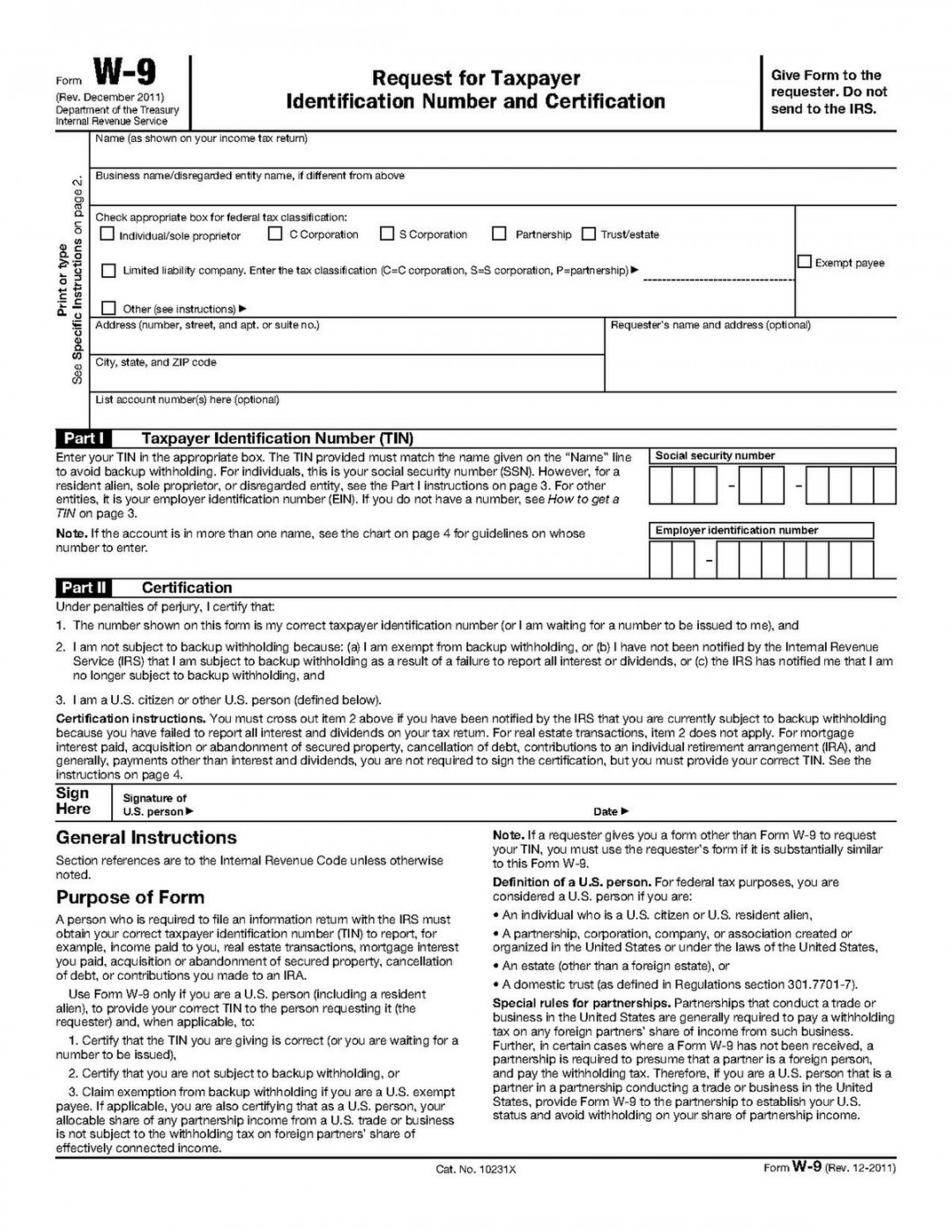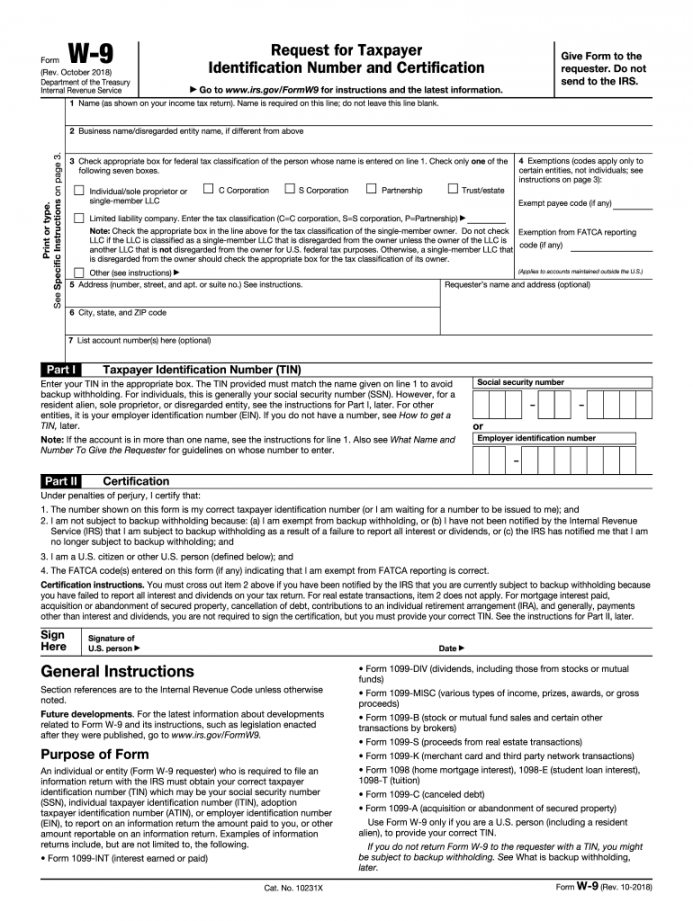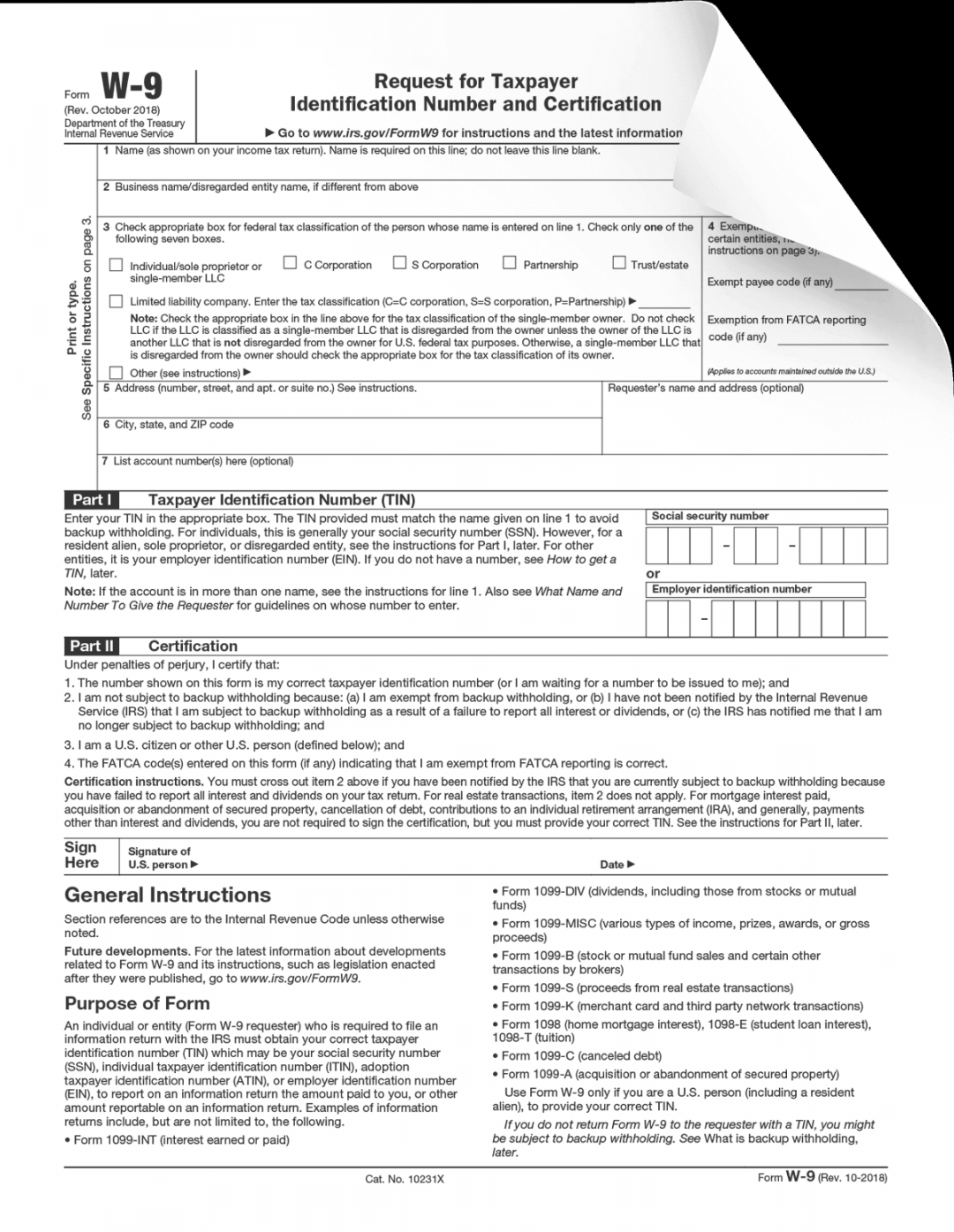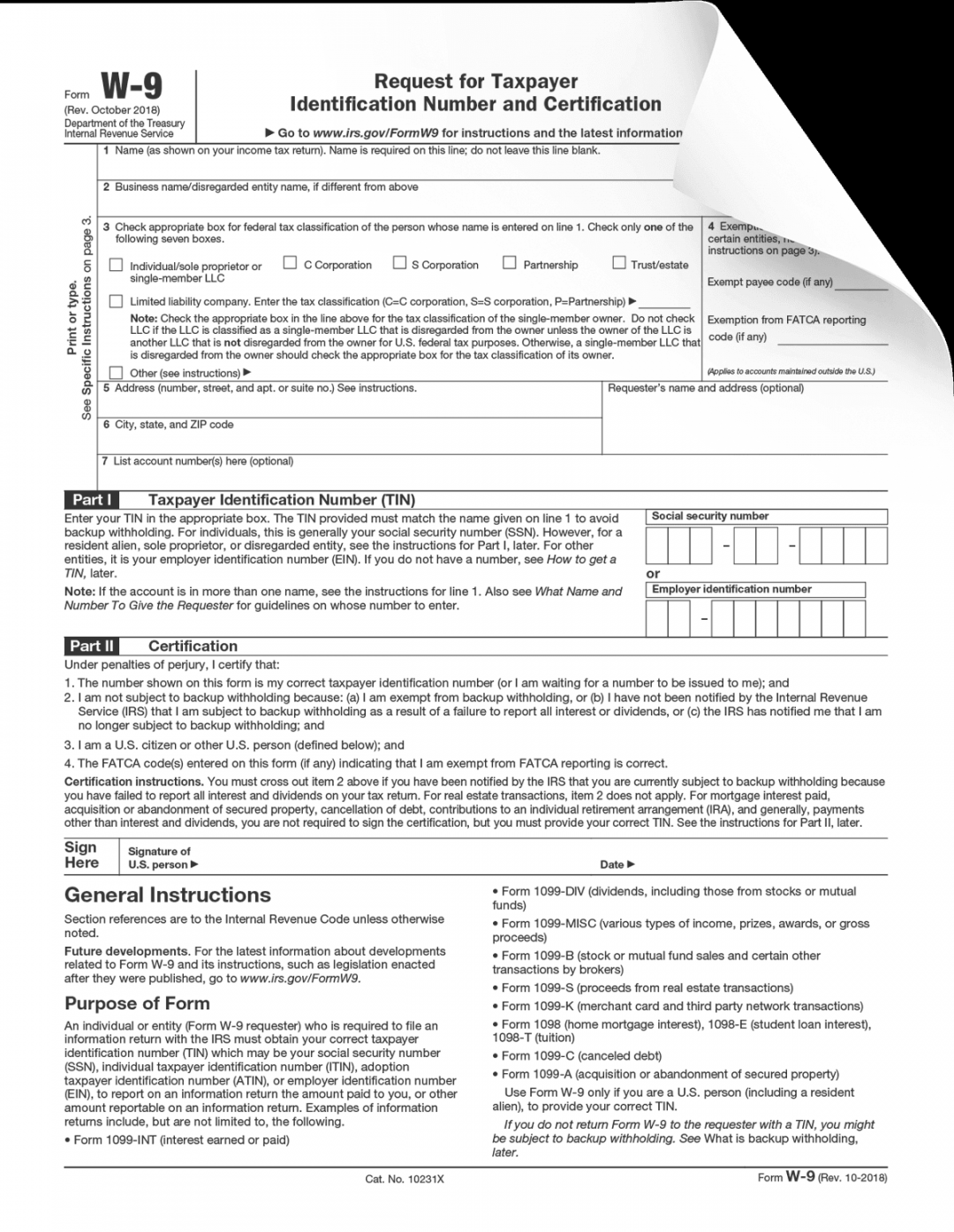Blank W 9 Forms
W-9 vs. 1099: What’s the Difference?
Often, an employee who works outside standard workplace hours to fulfill their role for you is an independent contractor instead of a full-time employee. This employee status difference is a vital distinction for all business tax operations. When hiring an independent contractor, you must become familiar with two tax forms in particular: Form W-9 and Form 1099-NEC.
What are W-9 and 1099 tax forms?
The distinction between W-9 and 1099 tax forms lies in who provides them and what kinds of financial and tax information each form contains. Here are the basics of each form.

What is Form 1099-NEC?
IRS Form 1099-NEC, aka “a 1099,” reports the income a business pays to taxpayers who are not full-time employees. Any employer that pays an independent contractor, freelancer, self-employed person or sole proprietor for services they provided must file Form 1099-NEC with the IRS for each of these payees and send a copy to the payee as well. An independent contractor who receives Form 1099-NEC from an employer must report that income on their tax return.

What is a W-9?
IRS Form W-9 tells an employer the legal name, address and taxpayer identification number (TIN) or Social Security number (SSN) of an independent contractor, freelancer, self-employed person or sole proprietor. An employer should ask for an independent contractor’s W-9 at the outset of the contractor’s work for them.

Alternatively, a freelancer should voluntarily provide a completed W-9 to each client before they start working. Because the information on Form W-9 rarely varies by employer, the completed form is quick and easy for independent contractors to share.
Do you need a W-9 for a 1099?
Technically, an employer does not need a W-9 from an independent contractor to issue them a 1099-NEC. In theory, any method through which an employer obtains an independent contractor’s taxpayer identification number or Social Security number is valid, as an employer only needs either of those numbers to issue a 1099 form.
Employers are nevertheless advised to use a W-9 to obtain a contractor’s TIN or SSN, because filing false information on a W-9 is illegal. Using the proper forms can protect employers from facing penalties for false information filed with the IRS. Independent contractors, not employers, are liable for incorrect information provided on Form W-9.
Who should get these forms?
An independent contractor should file Form W-9 with an employer. However, Form W-9 does not need to be filed with the IRS. Independent contractor tax preparation requires freelancers to get copies of their Form 1099-NEC from all of their clients. In addition to employers giving copies of Form 1099-NEC to their freelancers and independent contractors, they need to file these forms with the IRS and their state tax authority.
There is an exception to this requirement, however: An employer does not need to complete and file Form 1099-NEC for an independent contractor who is paid less than $600 in any of these categories within a given tax year:
RentAwards and prizesPayments for healthcare or to an attorneyCrop insurance proceedsCash paid by a notional principal contract to an individual taxpayer, a partnership or an estateAny other miscellaneous income payments, including nonemployee income for services provided
Most employers pay independent contractors solely nonemployee income for services provided, though all of the other categories listed qualify as 1099 income if paid out.
W-9s and 1099s are tax forms that are required when employers work with an independent contractor. Form W-9 is completed by the independent contractor and provides details on who they are. Form 1099-NEC is completed by the employer and details the wages paid to the contractor.
What constitutes an independent contractor?
At its most fundamental, the definition of an independent contractor is anyone who performs services for your company without being bound to the same requirements as your full-time employees. For example, if you run a media outlet and hire a journalist who is not on your full-time staff to write stories for your publication, that journalist would be an independent contractor.
Chances are that you are paying this journalist a prespecified rate for each story they write. The journalist will invoice you when they file the story, and you will fulfill the invoice without deducting any money from the payment. This payment practice is crucial to the difference between an independent contractor and a full-time employee: Whereas an employer uses an employee’s W-2 to determine how much money to deduct from their paychecks as tax withholding and payroll tax (often including income tax), an employer is not required to deduct payroll tax or account for tax withholding when paying a 1099 contractor. Similarly, when you hire independent contractors, employers are not required to follow state and federal regulations for employee benefits.
The distinction between a W-2 employee and a 1099 contractor means that an independent contractor must put aside a portion of their clients’ payments for income tax, whether quarterly or annual (or both). This difference in employee status also means that an independent contractor is responsible for their own health insurance, retirement account and other plans that might normally be covered under full-time employee benefits. (Our picks for the best employee retirement plans include options for self-employed people.)
An independent contractor is someone who completes work for your company but isn’t held to the same requirements as a full-time employee.
How else can an independent contractor be distinguished from a full-time employee?
As a business owner, you should determine whether a person providing services to your company should be offered full-time employment or kept as an independent contractor. (Contractors who consistently work for a certain employer over an extended period are sometimes known as “permalancers.”) If the person meets any of the below criteria, they should likely be classified as an independent contractor:
They set their own hours. Unlike full-time employees, who are often bound to certain work hours or office presence requirements, an independent contractor can work whenever they like and come and go from your office (or their home office) as they please.They use their own tools. To best understand this point, consider the freelance journalist example again. Whereas staff writers may use the company’s computers or content management system to draft articles, freelancers likely do not have access to these tools.They can refuse work. Whereas a full-time employee must perform the tasks you demand of them, independent contractors are their own bosses. If their schedules are too full, their income is large enough that they don’t want more work or they are simply uninterested in the work offered to them, they can refuse the assignment.They complete work in their own way. Employers do not control how independent contractors work, only the work they produce. According to the IRS, “The general rule is that an individual is an independent contractor if the payer has the right to control or direct only the result of the work and not what will be done and how it will be done.”What are the penalties for not submitting a 1099 and W-9?
If an individual receives income that doesn’t come from a salary or wages, they must submit a 1099-NEC with their tax returns. The IRS has strict penalties for not filing a 1099-NEC, including penalties for filing late or filing incorrectly. Employers face penalties if they don’t provide recipients with copies of their 1099-NEC.
Additionally, the due date for filing a 1099 depends on the type of 1099. The 1099-NEC is due by Jan. 31, and the 1099-S and 1099-B are due by Feb. 15. The penalties and fees vary. If an employer doesn’t provide a correct 1099, the penalty is $570; that fine is per contractor, not a flat fee. For example, if an employer has five contractors and doesn’t give them 1099-NECs, the employer could pay fees of up to $2,850.
The penalties for filing a 1099 increase as more time passes after the deadline. The penalty starts at $50 if filed within 30 days past the due date. It increases to $110 if you file after 30 days but before Aug. 1. All 1099s filed after Aug. 1 are subject to a penalty of $290.
If you hire contractors or freelancers, you are responsible for collecting a W-9 from them so you can provide a 1099-NEC for annual taxes. To avoid any penalties from the IRS, you must demonstrate that at least three attempts were made to obtain W-9 information. If the payee doesn’t provide W-9 information, they are subject to a $50 penalty per attempt.
What happens if you can’t get a TIN from a contractor for a 1099?
If your business does not get a TIN from a contractor, you could face penalties from the IRS. You must not only collect the TIN but also demonstrate that you are keeping the data private.
You must collect a TIN if you pay a contractor or freelancer more than $600 annually. If the contractor hasn’t provided a TIN but has given a SSN, you can use that number to process a 1099. If you cannot obtain a TIN or SSN, you should document your attempts in writing. The IRS requires that you show you made a minimum of three solicitations for the TIN. The contractor or freelancer is subject to a $50 per-attempt fee if they fail to comply. If you’re unable to get the TIN after three attempts, the IRS requires you to withhold 24 percent from all payments to the contractor or freelancer.
How to fill out a W-9 and a 1099
Form W-9 and Form 1099-NEC streamline the business owner’s workload come tax season. Both forms are straightforward to fill out, and they present crucial tax information in an organized, easily understandable way.
How to fill out Form W-9
Independent contractors can follow these steps to fill out Form W-9:
In box 1, write the same name you use on your tax returns, which is likely your legal name. Unless your middle name appears on your tax returns, exclude your middle name.In box 2, write your business name or disregarded entity name if you have one in addition to your legal name. In other words, if you are a sole proprietor who conducts business under a different name, write that name in box 2.In box 3, check the box corresponding to your business type: individual/sole proprietor or single-member limited liability company (LLC), C corporation, S corporation, partnership, trust/estate, LLC or other. As an independent contractor, you are an individual/sole proprietor or single-member LLC unless you have filled out the extensive paperwork to register your business name as a C corporation or S corporation.In box 4, detail your exemptions. In almost all cases, you can leave this box blank. The rare exceptions to this rule include corporations that are exempt from backup withholding and payees who are exempt from reporting according to the Foreign Account Tax Compliance Act — two circumstances that are virtually unheard of among freelancers.In boxes 5 and 6, write your address as directed. Use the same address as you do on your tax return.To the right of boxes 5 and 6, there is a space to list the name and address of the person or business that requested a W-9 from you. This space is optional to fill out but can be helpful for remembering all of the clients to whom you have given a W-9.Box 7, which says “List account number(s) here (optional),” can generally be left blank, unless the person requesting your W-9 directly asks you to enter bank account information on your form.After filling out these boxes, you will move on to Part I. Here, if you are a freelancer or sole proprietor, you will provide your SSN. If you are a business, you will provide your federal employer identification number (EIN). If your business is so new that it does not yet have an EIN but you have applied for one, you should write “applied for.”Now, move on to Part II. Read the four provided statements, and certify that they are true. Statement two concerns backup withholding, which you are exempt from unless the IRS has contacted you to tell you otherwise. You can also ignore statement four unless you have filled out box 4. If you can confirm that all four statements are true, sign and date the form where indicated.File the completed form with the entity that requested it.
If you need more help, refer to the “General instructions” section below Part II of your W-9.
How to fill out Form 1099-NEC
Business owners can follow these steps to fill out Form 1099-NEC:
Note that you must fill out five copies of Form 1099-NEC: one for the IRS, one for your state tax department, two for the 1099 recipient (the independent contractor) and one for your own records.In the large box on the top left, write your business’s name, address and telephone number.In the two boxes below the address box, write your TIN and your recipient’s TIN where indicated.Below the TIN boxes, enter your recipient’s name and address.When documenting nonemployee income paid to an independent contractor, you can almost always leave the “account number” box below the recipient’s address blank. In box 1, enter all money paid to the contractor.Check box 2 if applicable, and do not add anything to box 3.Leave boxes 4 and 5 blank, since you do not withhold taxes when you pay independent contractors. Boxes 6 and 7 are entirely optional.
When you fill out these forms, go line by line to ensure you are following the proper steps.
What are the tax deadlines for Form 1099-NEC?
Form 1099-NEC is filled out after a tax year ends. The deadline to file 1099-NEC forms with payments to nonemployees to the IRS and your state tax authority is Jan. 31 the year after the tax year. Put more simply, you must file all 1099-NEC forms that indicate payments to nonemployees for the 2023 tax year by Jan. 31, 2024. For other types of reported payments, such as 1099-S or 1099-B forms, the 1099 filing deadline is Feb. 15.
What are the tax deadlines for Form W-9?
Form W-9 is not subject to IRS deadlines, since the IRS does not collect this form. However, because employers must file Form 1099-NEC by Jan. 31, independent contractors who do not provide a W-9 upon starting work with a new client should file the form with their client as soon as possible. Business owners can also request Form W-9 from contractors as needed between the end of the year and the 1099 filing deadline.
Even though there are no deadlines for Form W-9 submissions, independent contractors should be aware of the quarterly tax deadlines that come with freelancing. While learning about Form W-9, you may want a refresher on self-employed accounting basics and freelance tax deductions as well.
Filing your final forms
Many of the best accounting software platforms and tax services make it easy to complete and file 1099 and W-9 forms. These platforms also may streamline the corresponding payments, and their compliance tools will keep you heeding regulations year-round. The result is invaluable time back for other business needs and a near guarantee that your tax paperwork will be correct every step of the way.


